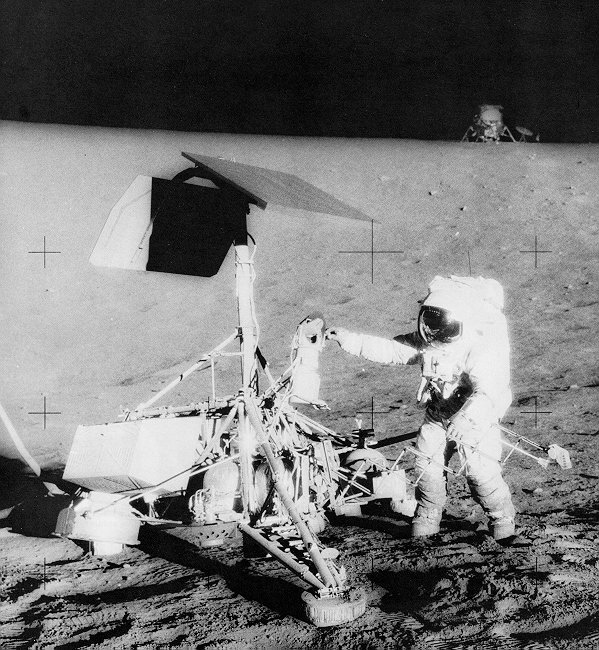
Ocean of Storms and Fra Mauro
By CHARLES CONRAD, JR., and ALAN B. SHEPARD, JR.

|
| Apollo 12 Astronaut Alan Bean examines Surveyor III's camera. The two astronauts walked down to the spacecraft from their own lunar module, which they had landed about 600 feet away. They removed the TV camera and the scoop so that scientists could study the effects on well-known materials of a 31-month lunar sojourn. A third spacecraft, Lunar Orbiter III, made the pinpoint landing possible by its earlier feat of photographing the site in exquisite detail. |
Scientific exploration of the Moon began in earnest with the Apollo 12 and 14 missions. Four astronauts worked on the Moon in four-hour shifts, walking from site to site. The Apollo 12 astronauts carried everything: experiments, equipment, tools, sample hags, cameras. The Apollo 14 team had a small equipment cart, and some of the time it was a help. But the missions showed that a man in a pressurized suit had definite limitations on the rugged and perplexing lunar surface. It was more work than it seemed, and in the case of Apollo 14, medical advice from Earth ended one phase of activity. But the two missions produced a wealth of new scientific data and lunar samples, and both laid a firm foundation for the great voyages of lunar exploration to follow.
The sky was cloudy and rain was falling on November 14, 1969, as the Apollo 12 crew prepared for launch. Half a minute after liftoff a lightning strike opened the main circuit breakers in the spacecraft. Quick action by the crew and Launch Control restored power, and Astronauts Charles "Pete" Conrad, Jr., Richard F. Gordon, and Alan L. Bean sped into sunlight above the clouds. "We had everything in the world drop out", Conrad reported. "We've had a couple of cardiac arrests down here too", Launch Control radioed back.
Their destination was the Ocean of Storms. Four and a half days later, Conrad and Bean entered the lunar module Intrepid and separated from Gordon in the command module Yankee Clipper. Their landing site was about 1300 miles west of where Apollo 11 had landed, on a surface believed covered by debris splashed out from the crater Copernicus some 250 miles away. The exact site was a point where, 31 months before, the unmanned lunar scout Surveyor III had made a precarious automatic landing. The Surveyor site was a natural choice: it was a geologically different surface, it would demonstrate pinpoint landing precision, and it would offer a chance to bring back metal, electronic, and optical materials that had soaked for many months in the lunar environment.
Here is Pete Conrad's account of the mission:
It was really pioneering in lunar exploration. We had planned our traverses carefully, we covered them, and we stayed on the time line. We had a real-time link with the ground, to help guide our work on the surface. Of course we had practiced a lot beforehand. working with geologists in the field to learn techniques from them while they learned what we could and couldn't do in the lunar environment.
Our first important task was the precision landing near Surveyor III. When we pitched over just before the landing phase, there it was, looking as if we would land practically on target. The targeting data were just about perfect, but I maneuvered around the crater, landing at a slightly different spot than the one we had planned. In my judgment, the place we had prepicked was a little too rough. We touched down about 600 feet from the Surveyor. They didn't want us to be nearer than 500 feet because of the risk that the descent engine might blow dust over the spacecraft.
Our second important task- and of course the real reason for going to the Moon in the first place- was to accomplish useful scientific work on the surface. We had to set up the ALSEP and its experiments; we had to do a lot of geologizing; and finally we had to bring back some pieces of the Surveyor, so they could be analyzed for the effects of their exposure.
Al Bean and I made two EVAs, each lasting just under four hours; and we covered the planned traverses as scheduled. We learned things that we could never have found out in a simulation. A simple thing like shoveling soil into a sample bag, for instance, was an entirely new experience. First, you had to handle the shovel differently, stopping it before you would have on Earth, and tilting it to dump the load much more steeply, after which the whole sample would slide off suddenly.
| Next |